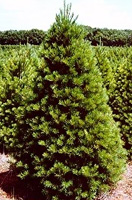Following are the most common types of Christmas trees grown in Tennessee:
Eastern White Pine (Pinus Strobus)

Eastern White Pine needles are soft, flexible and bluish-green to silver green in color and are regularly arranged in bundles of five. Needles are 2 1/2-5 inches long and are usually shed at the end of the second growing season. For Christmas trees, sheared trees are preferred as shearing results in dense trees. Needle retention is good to excellent. White pine has very little aroma, but, conversely, is reported to result in fewer allergic reactions than do some of the more aromatic species.
Fraser Fir (Abies Fraseri)

The combination of form, needle retention, dark blue-green color, pleasant scent and excellent shipping characteristics has led to Fraser fir being a most popular Christmas tree species. Fraser fir and balsam fir are quite similar. The Fraser Fir is one of the most fragrant of Christmas trees found today. Normally grown at elevations above 3,000 feet in the Appalachian areas of northeastern TN and western North Carolina, many southern growers import Fraser Fir from these areas to satisfy customer demand for this valuable tree.
Leyland Cypress (Cupressocyparis Leylandii)

The foliage of the Leyland cypress tends to be arranged in irregularly flat planes with a dark green to gray color. The shoots branch repeatedly and have a contrasting mahogany color except at the tips. The trees have little aroma. Customers like it because it is not only a very beautiful Christmas tree, but if kept in water, it will outlast any other tree without leaving needles in the carpet.
Norway Spruce (Picea Abies)

The Norway Spruce is readily identified by its dark green needles and drooping branchlets. Needles are 4-sided, 1/2-1 inch long, and sharp or somewhat blunt at the tip. For Christmas trees, overall color of Norway spruce is good to excellent. A continuous water supply is a must for Norway Spruce as a cut Christmas tree, and the use of tree preservatives is touted as prolonging its life in the home.
Scotch Pine (Pinus Sylvestris)

More properly defined as ‘Scots Pine’, this tree is usually referred to as a ‘Scotch Pine’. As a Christmas tree, Scotch Pine is known for its dark green foliage and stiff branches which are well suited for decorating with both light and heavy ornaments. It has excellent needle retention characteristics and holds up well throughout harvest, shipping and display. Color is likewise variable with bright green characteristic of a few varieties to dark green to bluish tones more prominent in others. This tree is difficult to grow in southern climates.
Virginia Pine (Pinus Virginiana)

Virginia pine is a short-needled pine with pleasant pine fragrance, dense foliage and good growth rates. It has been by far the most widely planted southern Christmas tree over the past three decades and still is the most common pine species at most farms in the Deep South. For growing, it requires much additional work, as it must be sheared (shaped) twice per year to retain its pyramidal shape.
Arizona Cypress (Cupressus Arizonica), Blue Ice

The Blue Ice variety of the Arizona Cypress is a unusual blue/gray in color and is an extremely fast grower, often reaching a saleable size 6-7 foot tree within 3-4 years. Becoming very popular at southern Christmas tree farms both for Christmas and for use as a landscape specimen.
Arizona Cypress (Cupressus Arizonica), Carolina Sapphire

Carolina Sapphire’s best characteristics include fast growth, a beautiful blue color and an excellent aroma. Many southern farms are presently planting limited quantities of this beautiful tree.
Canaan Fir (Abies Intermedia)

Canaan (pronounced “Ka-naan”, with emphasis on the last syllable) is a relative newcomer to the Christmas tree market. It has many similarities to both Fraser balsam firs in growth and appearance. It has good to excellent needle retention and makes a beautiful Christmas tree in the home. A close relative to the ‘Bracted Balsam’ it displays some characteristics of both it and the Fraser Fir. While it can withstand somewhat higher temperatures than the Fraser, it does prefer a cooler soil temperature than some southern locations. For those areas which are marginal for growth of the Fraser Fir, the Canaan is a worthwhile substitute for Christmas tree farms.
Colorado Blue Spruce (Picea Pungens)

Colorado blue spruce, or blue spruce, is an attractive tree often used for Christmas trees. Needles are 1-1 1/2 inches long on lower branches but somewhat shorter on upper branches. They are 4-sided and have a very sharp point on the end. Needles are generally dull bluish-gray to silvery blue and emit a resinous odor when crushed. Some trees have a more distinct bluish-white or silvery-white foliage year round. These are often referred to as ‘shiners’. Blue spruce is finding increasing popularity as a Christmas tree as a result of its symmetrical form and attractive blue foliage. The species has an excellent natural shape and requires little shearing. Additionally, needle retention is among the best for the spruces. Its popularity as an ornamental leads many consumers to use blue spruce as a living Christmas tree, to be planted after the holiday season.
Concolor Fir (Abies Concolor)

The Concolor Fir is an attractive tree with blue-green needles (often quite blue) with a unique aroma, once cut. Its citrus aroma is unique among Christmas trees, and its fine needle holding capability makes it a favorite choice for many real tree lovers during the holidays. It’s relatively slow to medium growth rate during the first few years is more than compensated by the beauty of a well formed specimen. Its growth habit prefers moist, well-drained soils, tolerating heat and drought conditions among the best of the fir varieties and will grow in sun to partial shade. It is grown both for Christmas trees, and ornamental stock in Zones 3-7.